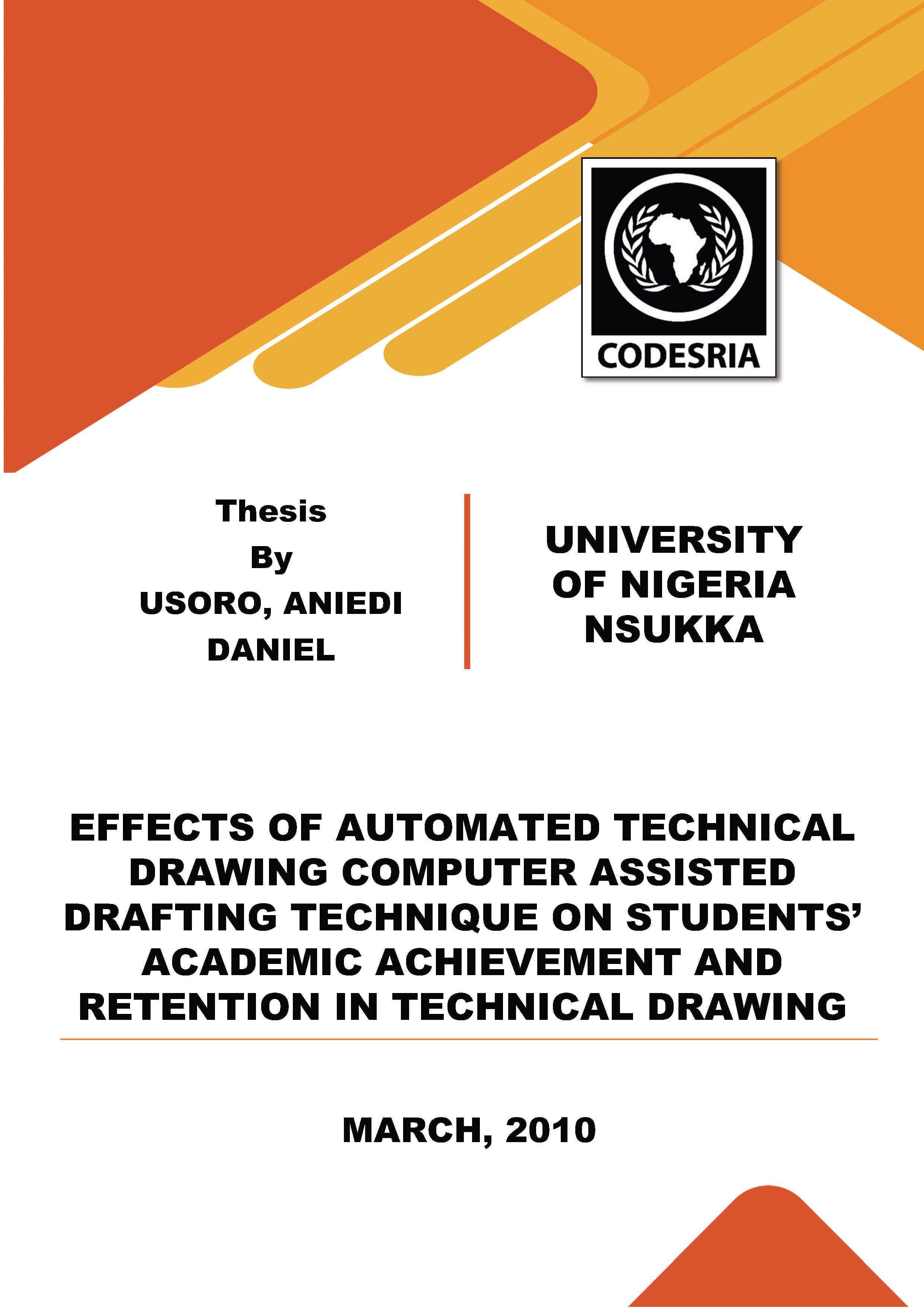EFFECTS OF AUTOMATED TECHNICAL DRAWING COMPUTER ASSISTED DRAFTING TECHNIQUE ON STUDENTS’ ACADEMIC ACHIEVEMENT AND RETENTION IN TECHNICAL DRAWING
Mots-clés :
COMPUTER, STUDENTS, RETENTIONSynopsis
The study sought to determine the effects of Automated Technical Drawing Computer Assisted Drafting Technique AUTOTEDRACAD on students’ academic achievement and retention in technical drawing. A quasi experimental pretest and posttest design was adopted because random selection of subject into treatment and control groups was not possible without disruption of the school programme under the study. The population of the study was 2110 technical year two students in eleven technical colleges in Akwa Ibom State. The sample comprised 240 students drawn from four technical colleges. Simple
random sampling technique was employed to select the colleges with purposively sample method used to determine the experimental and the control group. The instruments used for data collection was Technical Drawing Achievement Test (TDAT) constructed by the researcher and validated by the five experts, one from the department of Technical Education, University of Uyo, one from Science Education, University of Nigeria, and three from the department of Vocational Teacher Education, University of Nigeria, Nsukka. Automated Technical Drawing Computer Assisted Drafting (AUTOTEDRACAD) lesson plan
produced into software and conventional lesson plan were the instruments for treatment of the experimental and control groups. The research questions were analyzed using mean and standard deviation, while analysis of covariance (ANCOVA) was used to test the null hypotheses at 0.05 level of significance. The study among other things found out that there is a significant difference in academic achievement and retention of students taught with AUTOTEDRACAD technique than those taught with demonstration method. It was recommended that technical teachers should make use of AUTOTEDRACAD technique as it highlights a shift from teacher centered to an inclusive and integrated practice. It further revealed that it Improves understanding, develops creativity and promotes problem solving skills needed in construction and engineering industries.
Téléchargements
Références
Abdelhamid, T. M. (2005). The Multidimensional Learning Model: An Evaluation of its Effectiveness in improving Learning and Memory. Auckland 7(1), 79-81.
Adey, P., Robertson, A. & Venville, G. (2002) Effects of Cognitive AccelerationProgramme on year 1 Pupils, British Journal of educational Psychology 72 (1) 1-25
Akpan, A. A. (1999). Technical Skills Acquisition among Undergraduate during Industrial Work Experience Scheme. Journal of Creativity in Teaching for the Acquisition and Dissemination of Effective Learning. (CITADEL) 2(4) 99 – 109.
Akpan, M. P. (2000). Towards the Attainment of Qualitative Vocational Education in Nigeria: The Way Forward. Journal of Educational and Society 4(1) 35-39.
Ali, A. (1996). Teacher Education for Instructional Improvement. The Nigerian Teacher Today 1(2) 12 – 21.
Amuludun, K. A.; Lemo, O. O & Usoro, A. D. (2006). Effects of Multidimensional Learning Model on Students Academic Retention and Achievement in Technical Drawing. Journal of National Association of
Teachers of Technology (NATT) 6 vI. 89-97.
Anikweze, C. M. (1988). Evaluating the Effectiveness of the Use of Models Games and Simulations for Teaching Geography in Nigeria Post Primary Schools. Unpublished P.hD. Thesis. Department of Vocational Teacher Education. University of Nigeria, Nsukka.
Artheton, J. S. (2003). Learning and Teaching Intelligence. Retrieved on 10/10/2005 from www.dmu.ac.uk/lamesa/learning.intellig.html.
Bangert-Drowns, R. L., Kulik, J. A. & Kulik, C. C. (2006). Effectiveness of Computer-Based Education in Secondary Schools. Journal of Computer Based Instruction 12(3) 59 – 68.
Bar-Yam, M., Rhoades, K. and Sweeny, L.B., Kaput, J. & Bar-yam, M. (2006). Changes in the Teaching and Learning Process in a Complex Education System. UK, New England Complex Institute. Retrieved on 29/7/06 from http://www.necsi.ord/guide/index.html.






